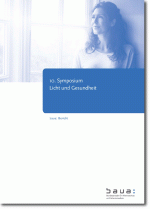Linking the non-visual effects of light exposure with occupational health
In May 2018, the Federal Institute for Occupational Safety and Health (BAuA, Germany) hosted "Light and Health at Work", a workshop concerning occupational health issues relating to non-visual effects of light of both indoor and shift workers. The agenda reflected a common interest in translational research linking laboratory findings with occupational and public health outcomes, and resulted in the founding of the European scientific network NoVEL (standing for Non-Visual Effects of Light). This article sets out the network participants’ shared goals to improve the scientific evidence about light’s non-visual effects, circadian disruption and well-being, using light exposure interventions with high quality assessment of light.
The main work conditions that impair exposure profiles that support healthy circadian regulation are daytime indoor work that reduces light exposures and night-shift work that increases light-at-night (LAN).
The complete article is published in the "International Journal of Epidemiology" (2019).
Bibliographic information
Title: Linking the non-visual effects of light exposure with occupational health.
in: International Journal of Epidemiology, Volume 48, Issue 5, 2019. pages: 1393-1397, PDF file, DOI: 10.1093/ije/dyz131
